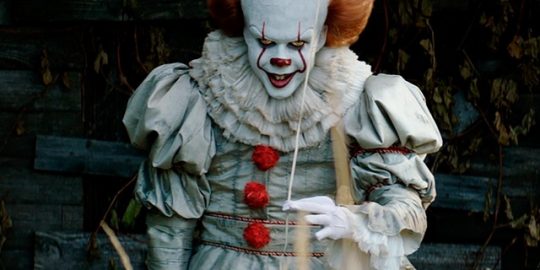I quite liked Matt Zoller Seitz's essay on It, which he describes as not necessarily a great movie but a great audience movie. Here's Seitz:
And it has been made with a big screen in mind. The moments of suspense and shock have been timed (by editor Jason Ballantine) to make the audience giddy with anticipation, then flood the screen with bursts of audiovisual noise to camouflage any yelps or screams, then ramp down to relative quiet so that viewers can laugh about how scary a moment was or lie about not having been scared at all.
As an aside, I love this graf just as a piece of critical writing. It's almost casually tossed off at the start of the essay, a small observation about audience reactions. But, in actuality, it's a rather insightful and perfectly concise lesson in sound mixing, the sort of criticism that will help casual readers understand the art of film and the way movies work.
Anyway, Seitz's point is that this is a perfect movie to see with audiences:
Horror, perhaps more so than any other genre, thrives on the communal experience. The audience is jacked up on adrenaline (or something else). Their investment in the movie becomes part of the show, and as long as the merger happens organically, as a result of whatever the film is doing to them from moment to moment, the result can be a sublimely raucous night out. ... During the first 15 minutes, a teenager sitting behind me commented to his friend, "The volume is louder than last night."
Given that the movie grossed more than $123 million over the weekend, it's no surprise that some are already headed back for repeat viewings—despite the fact that there are some weaknesses in the picture. As I've written elsewhere, I was, like Seitz, slightly disappointed in the way Derry's role in the story was reduced, minimized. The real horror of It, the novel, isn't so much Pennywise but the innate cruelty of the town that he terrorizes: its willingness to turn a blind eye to murder and mayhem; its bigotry and brutality toward those who are different.
But there are other ways in which Andy Muschietti's film improves upon—or at least adds to—the scares from the book. I must quibble slightly with this parenthetical from Seitz:
(the only girl in the group, Sophia Lillis' Bev Marsh, gets drowned in blood a la "The Shining" elevator soon after buying tampons, a vision worthy of Brian De Palma's original "Carrie," but there's little sense of the two moments being symbolically connected, a conspicuous failure for a horror film of this type)
What's interesting about the scene Seitz highlights here isn't so much the blood spouting from the bathroom sink—though there is blood, and lots of it—but what else is present.
Viewers of the film will remember that Beverly had, previously, cut her hair in that very bathroom in an effort to make her look less like a girl and more like a boy. She chopped off her locks and washed them down the drain because of the (untrue) taunts she had endured for being a "slut" at school and the unwanted attention she was subjected to at home from her drunken lech of a father. It's a perfectly childlike, frankly heartbreaking way for a kid to deal with trauma: a modest self-mutilation, an attempt to reassert control over her body while also reducing the likelihood of being preyed upon by the horrors outside (and within) her home.
When Pennywise attacks her, he doesn't just send up a geyser of (menstrual) blood—he also shoots up strands of hair, hair that grabs Bev, chokes her, pulls her toward the drain and death and destruction. Pennywise's great strength is that he knows what terrifies children—and it ain't always a creep in greasepaint holding a balloon. What terrifies Bev, for instance, is the way everyone around her reacts to the fact that she is growing up into an attractive young woman. So what does Pennywise use to attack her? Symbols of the same.
Muschietti, directing a long-gestating script by Chase Palmer, Cary Fukunaga, and Gary Dauberman, ramps up the individual jump-scare-type scenes from the original ABC miniseries and the book. Stanley Uris doesn't see Pennywise whilst birdwatching, for instance; he is, instead, terrorized by a horrifying painting of a grotesquely distorted woman playing a flute. She emerges from the painting, limbs akimbo, a haunting melody emanating from her instrument—a perfect symbol for the way in which art can chill us. Ben Hanscomb, meanwhile, is terrorized by a headless boy, the spirit of a child killed decades before in an explosion at the local ironworks. The stumbling decapitated apparition's unreality makes its appearance in the very real library stacks too irrational to deal with: This is pure terror we're seeing.
Again, It is not a great movie. But it is a particularly effective movie, insofar as it succeeds in what it set out to do: tell a coming-of-age story that makes you jump in your seat every once in a while by delivering scares that are both individually targeted at the characters and still somewhat universal for audiences. It's no wonder they're lapping it up.
